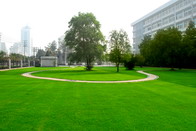Invited by State Key Laboratory of Geodesy and Earth`s Dynamics (SKLGED), professor Victor C. Tsai from California Institute of Technology visited Institute of Geodesy and Geophysics(IGG) and gave two academic reports in title“Quantifying Natural Hazards: From Earthquake Damage to Debris Flows” and “Exact Surface-wave Green’s Functions and Applications” on May 23.
In his first report, professor Victor C. Tsai took wave propagation on a rope as an example, showed the amplitude amplification effects of seismic waves propagating in different density media. In the study of earthquake disaster evaluation the amplification effect of vertical incident S-wave is considered, but the amplification effect of real wave is not negligible. He introduced their research result in Los Angeles Basin which revealed the amplification of Rayleigh surface wave, Love surface wave and S-wave were different. In most cases, the amplification of the surface wave is larger than the amplification factor of the S-wave. If we don’t take into account the amplification effect of surface wave, we will underestimate peak acceleration in earthquake disaster assessment. Then, he also introduced the mechanism of seismic signal of debris flow disaster and showed a debris flow experimental results, comparing the theoretical simulation and actual seismic signals recorded and found that the two have very high consistency.
In his second report, professor Victor C. Tsai introduced two methods to extraction Surface-wave Green’s Functions, numerical simulation and analytic calculation. The former is more accurate and its application is very simple. The latter principle is more clear and it can greatly save computing resources. It was found that the surface wave characteristic function was very close to the different earth structure model by analytic calculation method. So he proposed the Dix inversion method, which can use the phase velocity dispersion to invert the S-wave velocity structure. The method used linear inversion, the calculation program was simple and have high efficiency, and it has very important application value.
Professor Victor C. Tsai received his Ph.D. in geophysics from Harvard University in 2009 and respectively worked as a postdoctoral researcher at the Harvard University and the United States Geological Survey in 2009 and 2011. He is mainly engaged in seismic imaging of new methods, noise imaging accuracy, glacier earthquakes and other aspects.

Professor Victor C. Tsai is giving the report.

